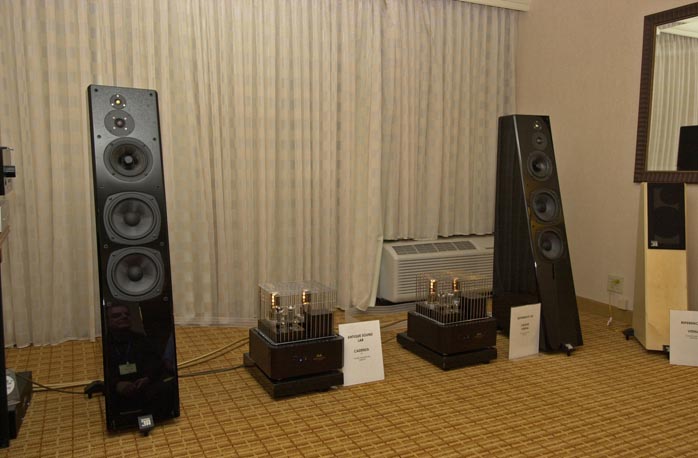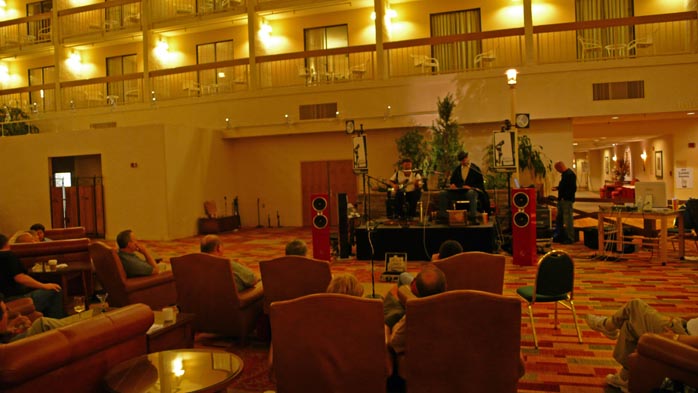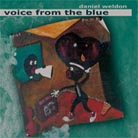 |
|||||||||||
 |
|||||||||||
Soundsmith uses a lot of wood together with novelties like their Strain Gauge cartridge. Just as last year, they had set up a great-sounding room where music enveloped us like a warm bath. Harmonic Technology was deep into the new Inex Innovation in-cable amplifiers. First they'd introduced electro-optical and optical-electrical conversion techniques to defy outside influences in their light-fiber cables. With the help of Inex now, this conversion process extends to the amplification stage. The output from a preamp, here an Inex A200, is amplified by the power amplifier in the speaker cable. At the Brussels show which we covered, we had not yet heard the results as the devices there were on silent display. We have to say that what we heard now coming from the Dali loudspeakers was very attractive. We played some tracks from our CD and were positively surprised. We already made arrangements to audition the Amplicable in our own environment. |
|||||||||||
 |
|||||||||||
| The Beveridge G3 ESL is a wave-guided panel loudspeaker. Even though it is very narrow for an ESL, the sound was wide enough thanks to the acoustic lens formed by the waveguide. Two subs reinforced the lowest signal regions as faithfully delivered by a pair of Joule Electra amps. |
|||||||||||
 |
|||||||||||
It is something typical American - to tweak the living shit out of everything. If something is stock, it must be personalized or at least altered, no matter the subject, from your own body to your dog, your car, bike, hawg and of course, your stereo. If you don't DIY, there are plenty of companies who luv to do it for you. And with good results. Here was The Upgrade Company that performs its magic even on Esoteric and EMM Labs goods, with differences that were apparent in A/B comparisons. |
|||||||||||
 |
|||||||||||
In the room next door the standard, stock, 'plain ol' vanilla' Esoteric equipment made successful music just as it was. |
|||||||||||
 |
|||||||||||
A pair of Reference 3A Grand Veena was coupled to Antique Sound Lab amplification. Though the looks of the amplifiers could be improved by removing the rat cages -- hey, a tweak -- the sound was fine. |
|||||||||||
 |
|||||||||||
The last room we visited was full of surprises. Synergistic Research had teamed up with Single Power and VRS. To start with the latter, Vincent Sanders now expanded his VRS digital music source into a 3-box set to enhance quality even further. In the room, Single Power was responsible to preamplify the VRS-delivered signal. The Maestro ZR3 was on duty into a pair of Red Dragon class-D monoblocks in wooden frames. For speakers, the Thiel 2.4s stood in. Cabling of course was by the Synergistic Research firm, one of whose signature features is active shielding. This means an active current is running alongside the cable to shield the fragile audio signal from the big bad world surrounding it. This current is sourced from a battery or AC power supply. Alas, much to their own surprise, the outcome of active shielding is not straightforward. It is highly dependant on the quality of the juice running through the extra non-signal conductors. Among NOS tubes found in military warehouses, Mikhail Rotenberg had dug up some 1943 WE and 1932 GE Tungar mercury diode rectifiers. He used one of each in the Enigma, a switchable power supply for the cable's active shielding, tubes regulated by a Mosfet. With this Enigma box, it was easy to switch between both tubes. During the demonstration, the room was darkened to show off the tubes' mercury gas lit up brightly. The Enigma was switched from WE to GE and the differences were spectacular, the GE opening up the sound dramatically which collapsed again and got a bit drier when switching back. What was going on even tube wizard Mikhail could not explain, simply changing the tube handling the bias power running along the signal in the speaker cable. It is commonly known that an electrical signal does not run through a cable. It merely uses the cable as quasi rails, as a guide to run along. Apparently, that signal is somehow influenced by another signal used as shield. And even though that signal has exactly the same measurable electric specifications coming from one tube as the other, it is audibly influenced by the choice of tube. Who woulda thunk? |
|||||||||||
 |
|||||||||||
| With our heads full of impressions, questions and surely more questions after visiting that last room, it was time for R&R in the Lift, the Marriott's bar. One of the nice things of RMAF in years past was the fact that almost all exhibitors also slept in the hotel. With the expansion of demo rooms this year, the hotel was booked solid and quite a few sleeping rooms had to be found elsewhere, like the nearby Hyatt. This meant that the Lift was no longer quite the central oasis for after-hour exhibitors and show goers. Nevertheless, we met quite a few folks at leisure while enjoying the contributions of the Zu people. As already mentioned, Adam Decaria and Sean Casey of Zu decided to turn their having lost last year's room into better fortunes by contributing live music to the event. In the atrium, they set up a stage and used their Zu speakers as location monitors and PA speakers. They had invited their friend Daniel Weldon to present the live entertainment. A selection of large couches and chairs faced the podium and even though the atrium is large, the after-dark atmosphere through the glass ceiling made it cozy. |
|||||||||||
 |
|||||||||||
Daniel Weldon is a singer-songwriter from Ogden in the Salt Lake City area of Utah. He has a voice close to Bob Dylan's but his repertoire differs - Weldon adds more rock to a mix that also includes a heavy dose of Mississippi blues that beautifully matches his at times very raw, melodic voice. His finger-picking guitar style is pure Country Blues yet the guitar is not his only instrument. Next to other stringed axes, he also played the Porch Board, a remarkable instrument that pounds out 30Hz to 100Hz acoustically created bass. It consists of two wooden bars connected at foot's length to each other. By tapping your toes and heels on both, it generates stompin' bass. |
|||||||||||
 |
|||||||||||
Daniel is not only a solo artist but together with 'Bad' Brad Wheeler on harmonica, forms the Porch Pounders. With Bad Brad present in the atrium at times, they delivered a truly steaming and pounding act. The Zu speakers did not cave in, played at the appropriate level and had plenty of head -- and bottom -- room to spare. Even when hit hard, the Porch Board with its thundering bass proved no challenge to the 8 woofers of two Zu Definition 2s that took pride of place in flaming red lacquer next to the podium. |
|||||||||||
 |
|||||||||||
After the show we met Daniel, Adam and Sean and learned more about their music and backgrounds. Sean arranged for us two copies of Daniel's independently released albums Voice from the Blue and The Soul of a Man. |
|||||||||||
 |
|||||||||||
 |
|||||||||||
| Then it was time to leave the next morning, not straight home but with a brief NYC interlude for some heavy shopping and rest. To get there was another story. We have to say that together with Las | |||||||||||
| Vegas, Denver airport is the worst US airport we have encountered thus far. Being spoilt by Delta's dedicated JFK terminal where you whiz through security, Denver was truly atrocious. After checking in our bags, we proceeded to security. We were 2 hours early to have sufficient time for the lounge. A friendly airport attendant pointed us at the North side of the tented central hall where the lines for the security check were the shortest - according to him. Ha, how wrong he was. Arriving at the North side, the zigzagging waiting queue was packed so we proceeded to the tail of it which led us through a hallway, through the baggage claim area and then outside! A quick calculation resulted in a 3-hour guesstimate to get to the window. No way, let's try for the South side of the hall. There only the zigzagging part of the hall was filled and we could join the line within the boundaries. It took a mere 90 minutes to pass security so we had a few precious extra minutes for the lounge. The rest of the journey to NYC and, a few days later to Amsterdam, went smoothly as long as we forget about the car that took us from the hotel to JFK on our way out, almost broke down and then proceeded at 25MPH top speed. So, was RMAF 2007 worth our while in the face of all these traveling nightmares? Most definitely! One easily forgets all the nastier parts to remember all the pleasant things and people seen and heard. Once again, thank you Marjorie, Al and the rest of the crew who made RMAF what is so uniquely RMAF. |
|||||||||||
 |
|||||||||||
 |
|||||||||||
 |
|||||||||||
 |
|||||||||||